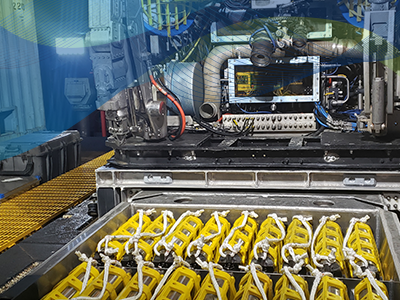NEWS
Reports Fourth Quarter and Fiscal Year 2020 Results & Announces Stock Repurchase Program
November 19, 2020 geospace
Geospace Technologies (NASDAQ: GEOS) today announced a net loss of $19.2 million, or $(1.42) per diluted share, on revenue of $87.8 million for its fiscal year ended September 30, 2020. This compares with a net loss of $146,000, or ($0.01) per diluted share, on revenue of $95.8 million for the comparable year-ago period.
For the fourth quarter ended September 30, 2020, the company reported revenue of $21.5 million and a net loss of $3.9 million, or ($0.29) per diluted share. For the comparable period last year, the company recorded revenue of $28.9 million and net income of $8.7 million, or $0.63 per diluted share.
The company noted that both the 2019 fiscal year and the fourth quarter periods benefited from a $7.0 million gain on the sale of non-essential real estate. Also noted, fiscal year 2020 operating income includes a $0.7 million non-cash charge for goodwill impairment in the company’s oil and gas segment, and a $1.1 million non-cash charge for changes in contingent consideration whereas fiscal year 2019 benefited from a $2.1 million reversal.
Walter R. (“Rick”) Wheeler, President and CEO of Geospace Technologies (the “Company”) said, “The spread of the novel coronavirus that began in late 2019 and early 2020, continues to negatively impact economies around the world. In response to this pandemic, we have continued to maintain our steadfast commitment to the health and safety measures implemented earlier this year. These measures are designed to protect our employees, as well as ensure that we can continue to serve our valued customers in the fashion to which they are accustomed.
Wheeler continued, “Despite the negative impact that COVID-19 has had on each of our business segments, we are pleased to report that our fiscal year 2020 total revenue of $87.8 million remained within 8% of last year’s total, and that we generated over $18 million in cash from operations over the course of the year. Notably, this reported revenue figure does not include any amounts from the sale of a GCL land recording system, valued at $12.5 million, to one of our customers in the second quarter. The purchase included $10 million of financing through a promissory note, and by the end of September 2020, almost $5.0 million had been received toward this system, including interest charges. Principal payment amounts toward this sale are included on our balance sheet as part of non-current deferred revenue, which we intend to recognize at a later date when collection of the note is deemed likely.”
Wheeler further noted, “As was the case throughout the fiscal year, our fourth quarter results continued to be fueled by demand for our OBX ocean-bottom recording systems. Moreover, rental contracts for our OBX marine systems pushed revenue from our wireless exploration products above last year’s mark. This helped to partially offset the reduced demand for our other oil and gas segment products, as well as the lower demand we experienced for products in our adjacent market businesses. The reduced demand was largely brought about by the negative impacts of COVID-19. Efforts to combat this disease have driven down the world’s demand for oil and gas, which has led to the largest supply and demand imbalance we’ve experienced. With a majority of seismic exploration activities currently suspended, demand for our oil and gas products remains limited. In addition, our adjacent markets graphic imaging products have seen similar setbacks. These products are used in the printing processes, merchandizing, and promotions of sports, entertainment, schools, tourism, and other social gathering events. Due to COVID-19, many of these activities have been curtailed, thus lowering demand for these products. In recognition of this lower products and rental demand and in keeping with our conservative management approach, we took steps to address our operating costs with a reduction in force in the third quarter of fiscal year 2020. Although a return to normalcy from these circumstances seems almost certain, the timing and extent of such recovery is unclear.”
Oil and Gas Markets Segment
Combined revenue from the Company’s Oil and Gas Markets segment totaled $14.2 million for the three months ended September 30, 2020. For the full fiscal year, revenue from this segment totaled $61.7 million. This compares with $20.8 million and $65.0 million for the equivalent three- and twelve-month periods a year ago, reflecting respective decreases of 32% and 5%. The decrease for the three-month period stems from lower demand for the Company’s wireless and reservoir seismic products and services, and for the full year period, reduced demand for its traditional and reservoir seismic products. Given the reduction in demand for oil and gas as a consequence of COVID-19, the Company’s Oil and Gas Markets segment will remain challenged as a result of minimal seismic exploration activity.
Revenue contributions to this segment from the Company’s traditional exploration products totaled $1.1 million and $6.7 million respectively for the three-month and full year periods ended September 30, 2020. These reflect an increase of 83% and a decrease of 30% compared to the same periods a year ago. The increase for the three-month period arises from comparing to last year’s historic low figure, while the decrease for the full year period is attributed to a persistent low overall demand for these products brought about by stark reductions in seismic exploration activities for oil and gas.
Segment contributions from the Company’s wireless seismic products totaled $13.0 million and $54.1 million respectively for the three- and twelve-month periods ended September 30, 2020. This equates to a 35% decrease and a 2% increase compared to the corresponding respective year ago periods. The fourth quarter decrease from last year is due to lower sales and rentals of the Company’s wireless products over the narrow three-month period. The full year comparative increase is a result of greater rental revenue during the year from the Company’s OBX marine nodal recording systems, partially offset by lower sales and rentals of its wireless land products. Demand for the Company’s OBX systems is driven by the desire of many oil and gas companies to find new resources near producing fields and to leverage existing offshore assets for their recovery to achieve lower cost. The Company’s rental of OBX systems is not immune from the reduced global demand for oil and gas, as such the Company expects reduced revenue from the rental of OBX systems in fiscal year 2021. Not recognized in the Company’s fiscal year 2020 revenue is the sale of a 30,000 channel GCL wireless land recording system, valued at $12.5 million. Payments received toward the system purchase are included in non-current deferred revenue on the Company’s balance sheet and are intended to be recognized as revenue at a future date when payment of a promissory note on the sale is likely.
The Company’s reservoir seismic products contributed $0.1 million and $0.9 million in total revenue for the three-month and full year periods ended September 30, 2020. This compares with $0.3 million and $2.7 million for the equivalent periods one year earlier, reflecting respective decreases of 56% and 65%. Reductions in engineering services and lower demand for the sale, rental, and repair of the Company’s borehole tools are responsible for the decreases in both periods. Management believes that contracts for the manufacture and deployment of permanent reservoir monitoring (PRM) systems offer the greatest opportunity for meaningful revenue from this product category. The Company has the largest installed base of PRM systems in the world, and offers configurations utilizing high-resolution electromagnetic motion sensors or OptoSeis® fiber optic sensor technology. In the fourth quarter of fiscal year 2020, the Company received a request from a major oil and gas producer to propose on the manufacture and installation of a large-scale seabed PRM system. In the event of a provided response, the potential customer is expected to award a contract in the second or third quarter of fiscal year 2021. If the Company were awarded the contract, revenue from the contract would not likely be recognized until the latter part of fiscal year 2021 and beyond. The Company is also continuing its ongoing discussions with other major oil and gas producers for possible PRM systems.
Adjacent Markets Segment
Combined revenue from the Company’s Adjacent Markets segment totaled $7.1 million and $25.4 million for the three- and twelve-month periods ended September 30, 2020. This compares with $8.0 million and $30.1 million for the equivalent year ago periods, representing decreases of 11% and 16% respectively. Lower sales of the Company’s sensors, cables, and connectors used in non-oil and gas industrial markets, and lower demand for its contract manufacturing services contributed to the decreases in both periods. In addition, reduced sales of the Company’s graphic imaging products further contributed to the comparative decrease over the full year period. In all cases, negative impacts of the COVID-19 pandemic are believed to be the primary cause of lower demand for the Company’s various adjacent markets products. As the effects of COVID-19 are abated, demand for the Company’s adjacent markets products will likely improve, but the extent and timing of possible recovery cannot be determined.
Emerging Markets Segment
The Company’s Emerging Markets segment generated revenue of $177,000 and $734,000 for the three-month and full year periods ended September 30, 2020. This compares with $14,000 and $159,000 for the similar three- and twelve-month periods of the previous year. For both periods, increased revenue is attributed to (i) the sale of border and perimeter security products to a commercial customer and (ii) initial site preparation and engineering related to a U.S. Customs and Border Protection, U.S. Border Patrol contract. Revenue from this $10 million contract, secured in April 2020, is expected to be recognized in the Company’s 2021 fiscal year. The contract is evidence of the Company’s successful execution of strategic diversification. Through its Quantum acquisition and analytics integration, the Company has leveraged its core engineering and manufacturing competencies to create novel products incorporating seismic acoustic technology and advanced analytics. These products provide unique technology solutions to government and commercial customers in the security, industrial, oil and gas, and other markets.
Balance Sheet and Liquidity
For the fiscal year ended September 30, 2020, the Company generated $18.1 million in cash and cash equivalents from operating activities. The Company used $4.1 million of cash for investment activities that included (i) $5.5 million invested in its rental equipment primarily to expand its OBX rental fleet, and (ii) $2.9 million for additions to property, plant, and equipment. These uses were partially offset by (i) $4.1 million of proceeds for the sale of rental equipment, and (ii) $0.2 million of proceeds from the sale of equipment. As of September 30, 2020, the Company had $32.7 million in cash and cash equivalents, and maintained an additional borrowing availability of $17.7 million under its bank credit agreement with no borrowings outstanding. Thus, as of September 30, 2020, the Company’s total liquidity stood at $50.4 million. The Company additionally owns unencumbered property and real estate in both domestic and international locations.
Wheeler concluded, “COVID-19 continues to exert a tight grip on the economies of countries around the world, and until there is a successful vaccine and infection rates consistently decline, there is no way to predict what a recovery will look like. Although the impact of the pandemic on some of our business segments was initially delayed, the negative effects have largely caught up. Seismic exploration activity will remain at a minimum as long as oil and gas supplies outstrip demand, and the lower energy demands brought about in reaction to COVID-19 reinforce this condition. As the businesses of some of our customers suffer from the pandemic’s effects, some of our adjacent market products will see reduced demand. However, much of our current efforts are focused on longer term strategic goals and projects of major customers looking further into the future. This includes oil and gas companies eager to find new reserves near existing assets using our OBX systems, as well as those intending to maximize recoveries of existing fields using our PRM systems. Transcending the pandemic is the critical mission of the U.S. Customs and Border Protection, U.S. Border Patrol, as we fulfill our contract to provide the Department of Homeland Security with a technology solution to protect our borders and society at large. We believe our strong balance sheet with no debt and ample liquidity gives us the fundamental strength to weather this pandemic and emerge on good footing. As such, we believe we are well positioned to leverage our comprehensive engineering and significant manufacturing operation in pursuit of new specialized industrial manufacturing customers and in support of national and homeland security missions. By maintaining our own manufacturing operation, we’ve de-risked our supply chain and enabled rapid time to market for new products, all of which make us highly attractive for partnership and fulfillment of commercial and government contracts. In other matters, I’d like to highlight the recent additions to our Board of Directors of Margaret “Sid” Ashworth, former Vice President of Government Relations for Northrop Grumman, and Kenneth Asbury, former President and CEO of CACI International. The experience each of them bring from such remarkable careers and accomplishments will bring fresh and diverse perspectives to our board and future strategies, creating new value for our shareholders.”
Stock Repurchase Program
The Company also announced that its Board of Directors has authorized a stock repurchase program under which the Company may purchase up to $5 million of its outstanding common stock. Under the repurchase program, the Company may purchase shares of common stock on a discretionary basis from time to time through open market transactions. The timing and number of shares repurchased will depend on a variety of factors, including stock price, trading volume, and general business and market conditions. The repurchase program has no time limit, does not obligate the Company to acquire a specified number of shares and may be modified, suspended or discontinued at any time at the Company’s discretion. The repurchase plan will be funded using existing cash or future cash flow.
Conference Call Information
Geospace Technologies will host a conference call to review its fiscal year 2020 full year financial results on November 20, 2020 at 10:00 a.m. Eastern Time (9 a.m. Central). Participants can access the call at (866) 518-6930 (US) or (203) 518-9797 (International). Please reference the conference ID: GEOSQ420 prior to the start of the conference call. A replay will be available for approximately 60 days and may be accessed through the Investor tab of our website at www.geospace.com.
About Geospace Technologies
Geospace principally designs and manufactures seismic instruments and equipment. We market our seismic products to the oil and gas industry to locate, characterize and monitor hydrocarbon-producing reservoirs. We also market our seismic products to other industries for vibration monitoring, border and perimeter security and various geotechnical applications. We design and manufacture other products of a non-seismic nature, including water meter products, imaging equipment and offshore cables.
Forward Looking Statements
This press release contains “forward-looking statements” within the meaning of Section 27A of the Securities Act of 1933, as amended, and Section 21E of the Securities Exchange Act of 1934, as amended. These forward-looking statements can be identified by terminology such as “may”, “will”, “should”, “intend”, “expect”, “plan”, “budget”, “forecast”, “anticipate”, “believe”, “estimate”, “predict”, “potential”, “continue”, “evaluating” or similar words. Statements that contain these words should be read carefully because they discuss our future expectations, contain projections of our future results of operations or of our financial position or state other forward-looking information. Examples of forward-looking statements include, among others, statements that we make regarding our expected operating results, the results and success of our transactions with Quantum and the OptoSeis® technology, the adoption and sale of our products in various geographic regions, potential tenders for PRM systems, future demand for OBX systems, the completion of new orders for our channels of our GCL system, the fulfillment of customer payment obligations, the impact of the coronavirus (COVID-19) pandemic, the Company’s ability to manage changes and the continued health or availability of management personnel, volatility and development, market position, financial results and the provision of accounting reserves. These forward-looking statements reflect our best judgment about future events and trends based on the information currently available to us. However, there will likely be events in the future that we are not able to predict or control. The factors listed under the caption “Risk Factors” and elsewhere in our most recent Annual Report on Form 10-K which is on file with the Securities and Exchange Commission, as well as other cautionary language in such Annual Report, any subsequent Quarterly Report on the Form 10-Q, or in our other periodic reports, provide examples of risks, uncertainties and events that may cause our actual results to differ materially from the expectations we describe in our forward-looking statements. Such examples include, but are not limited to, the failure of the Quantum or OptoSeis® technology transactions to yield positive operating results, decreases in commodity price levels, which could reduce demand for our products, the failure of our products to achieve market acceptance, despite substantial investment by us, our sensitivity to short term backlog, delayed or canceled customer orders, product obsolescence resulting from poor industry conditions or new technologies, bad debt write-offs associated with customer accounts, lack of further orders for our OBX systems, failure of our Quantum products to be adopted by the border and security perimeter market, and infringement or failure to protect intellectual property. The occurrence of the events described in these risk factors and elsewhere in our most recent Annual Report on Form 10-K or in our other periodic reports could have a material adverse effect on our business, results of operations and financial position, and actual events and results of operations may vary materially from our current expectations. We assume no obligation to revise or update any forward-looking statement, whether written or oral, that we may make from time to time, whether as a result of new information, future developments or otherwise.




